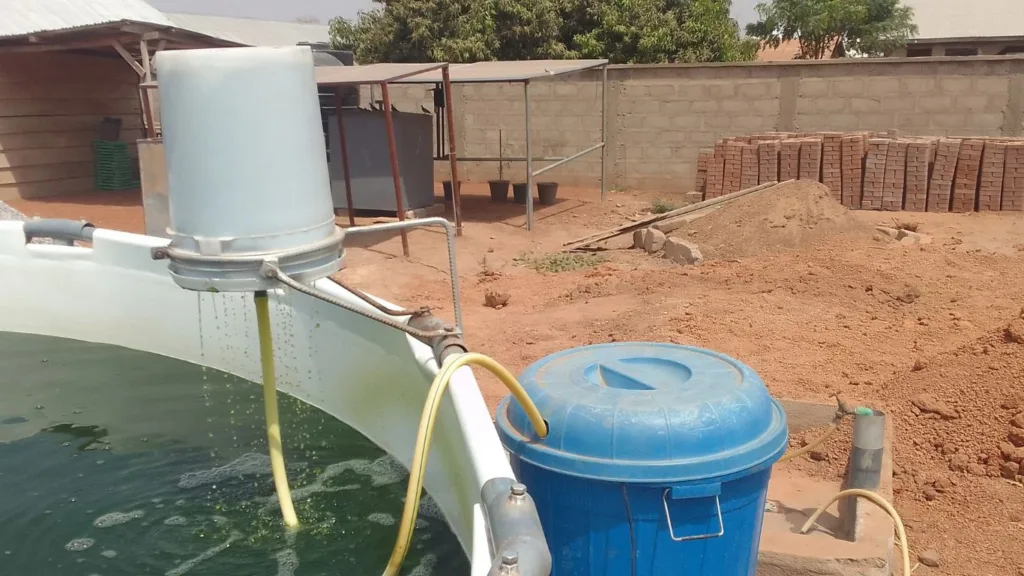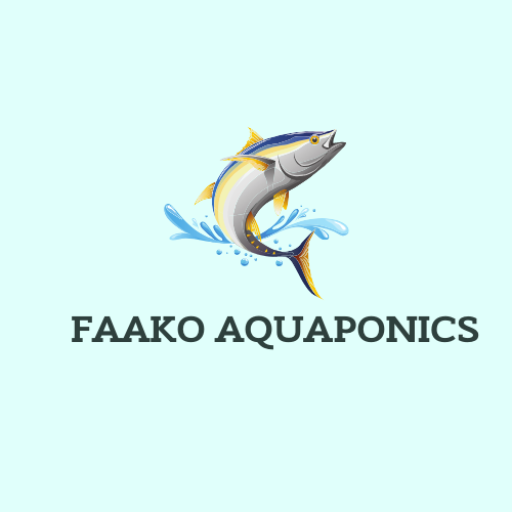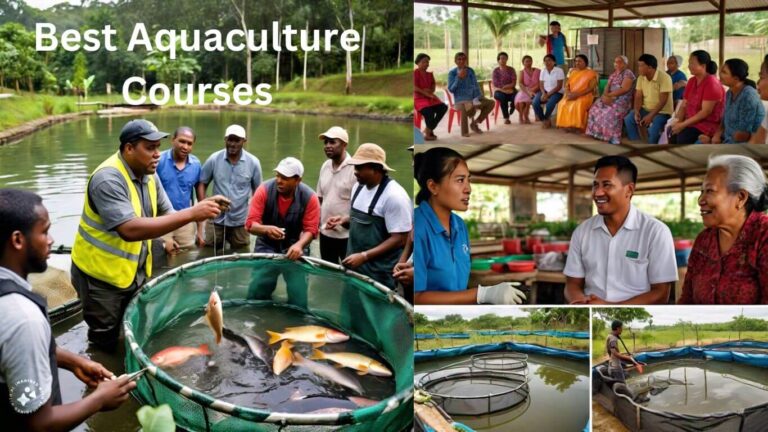Technology in fish farming is one of the key driving forces behind this transformational fish farming.
From advanced monitoring systems to automated feeding mechanisms, technology is playing a pivotal role in reshaping the landscape of modern fish farming.
The various ways in which technology is revolutionizing the aquaculture industry and its impact on sustainability, efficiency, and production are as follows.
Smart Monitoring Systems in Fish Farming
Smart Monitoring Systems in fish farming consist of a range of technological solutions designed to monitor and manage various aspects of aquaculture operations. These systems utilize sensors, data analytics, and connectivity tools to collect real-time data on crucial parameters such as water quality, temperature, oxygen levels, and fish behavior.
Components and Functionality in Smart Monitoring System
1. Sensor Technology
Smart Monitoring Systems are equipped with an array of sensors strategically placed throughout the fish farm.
These sensors continuously measure and monitor vital environmental factors, ensuring optimal conditions for fish growth and health.
2. Data Analytics
The data collected by sensors is analyzed in real time using advanced algorithms and machine learning techniques.
This analysis provides valuable insights into trends, patterns, and anomalies. This enables farmers to make data-driven decisions and take proactive measures to prevent potential issues.
3. Remote Accessibility
Fish Farmers can access real-time data and monitoring dashboards from anywhere, anytime, using their smartphones or computers. This remote access enhances operational efficiency and enables timely interventions, even when farmers are away from the farm.
4. Alert Systems
Smart Monitoring Systems are equipped with alert mechanisms that notify farmers of any deviations from preset parameters or potential issues.
These alerts can be received via SMS, email, or through dedicated mobile applications, allowing farmers to address problems promptly and minimize risks.
Benefits of Smart Monitoring Systems in Fish Farming
1. Improved Efficiency
By providing real-time insights and automating data collection processes, Smart Monitoring Systems streamline farm operations and optimize resource utilization. This leads to improved efficiency and cost savings for fish farmers.
2. Enhanced Fish Health and Welfare
Maintaining optimal water quality parameters is essential for ensuring the health and welfare of farmed fish.
Smart Monitoring Systems enable farmers to closely monitor water quality in real time, identify potential stressors, and take corrective actions promptly. This helps improve fish health and reduce mortality rates.
3. Environmental Sustainability
By enabling precise control over environmental factors, Smart Monitoring Systems contribute to environmental sustainability in aquaculture.
By minimizing the risk of pollution and resource wastage, these systems help mitigate the environmental impact of fish farming operations.
4. Data-Driven Decision Making
Smart Monitoring Systems empower farmers with actionable insights derived from data analytics.
By making informed decisions based on real-time data, farmers can optimize feeding regimes, water management strategies, and stocking densities, leading to higher yields and profitability.
Please Check out a Smart Monitoring System Device on Amazon for your farm.
Automated Feeding Solutions in Fish Farming
Feeding has long been recognized as a critical factor technology in fish farming, directly impacting growth rates, health, and overall productivity.
Traditional feeding methods often involve manual labor, subjective judgments, and inefficiencies, leading to inconsistent feeding regimes and potential overfeeding or underfeeding which both have consequences.
Components and Features of Automated Feeding Solutions
1. Sensors and Monitoring Devices
Automated Feeding Solutions are equipped with sensors to monitor key parameters such as fish activity, water temperature, oxygen levels, and feeding behavior.
These sensors provide real-time data insights, enabling the system to adjust feeding schedules and quantities accordingly.
2. Precision Feeding Algorithms
Advanced algorithms analyze sensor data and optimize feeding schedules and portion sizes to meet the nutritional needs of the fish while minimizing waste and environmental impact.
This precision feeding approach ensures optimal growth rates and feed conversion ratios, leading to improved efficiency and profitability.
3. Remote Monitoring and Control
Automated Feeding Solutions offer remote accessibility, allowing fish farmers to monitor feeding operations and adjust settings from anywhere, anytime, using smartphones or computers.
This remote control capability enhances operational flexibility and enables timely interventions, even when farmers are off-site.
4. Integration with Other Systems
These solutions can be seamlessly integrated with other aquaculture systems, such as Smart Monitoring Systems and Water Quality Management Systems.
This integration enables full farm management and data-driven decision-making, further enhancing overall farm performance and sustainability.
Benefits of Automated Feeding Solutions
1. Improved Feed Efficiency
By precisely controlling feed delivery based on real-time data and fish behavior. Automated Feeding Solutions minimize feed waste and optimize feed conversion ratios.
2. Enhanced Fish Health and Welfare
Consistent and optimal feeding regimes promote healthy fish growth and reduce the risk of stress-related diseases. Automated Feeding Solutions ensure that fish receive the right amount of feed at the right time, supporting overall fish health and welfare.
3. Labor Savings and Operational Efficiency
Automation reduces the need for manual feeding labor, allowing fish farmers to allocate resources more efficiently and focus on other aspects of farm management.
This labor-saving aspect improves operational efficiency and reduces operational costs in the long run.
4. Environmental Sustainability
By minimizing feed waste and nutrient discharge into the surrounding environment, Automated Feeding Solutions contribute to environmental sustainability in aquaculture.
The reduction in environmental impact helps mitigate the ecological footprint of fish farming operations.
Recirculating Aquaculture Systems (RAS) in Fish Farming
Recirculating Aquaculture Systems are self-contained, intensive fish farming systems that recycle and reuse water within a closed-loop environment.
Unlike traditional open-pond aquaculture, RAS minimizes water consumption and waste discharge by continuously treating and recirculating water through a series of filtration and purification processes.
Components and Operation of RAS
1. Water Filtration and Treatment
RAS employs a combination of mechanical, biological, and chemical filtration methods to remove waste particles, excess nutrients, and harmful compounds from the water.
This ensures optimal water quality for fish health and growth while minimizing environmental impact.
2. Water Recirculation
Instead of continuously discharging water into the environment, RAS recirculates water through the system, conserving water resources and reducing the risk of pollution.
Advanced pumping and circulation systems maintain water flow and oxygen levels, creating a stable and controlled environment for fish.
3. Biosecurity Measures
RAS provides a controlled environment that reduces the risk of disease outbreaks and contamination from external sources. Strict biosecurity measures, such as quarantine protocols and disinfection procedures, help maintain fish health and prevent the spread of pathogens.
4. Monitoring and Control Systems
RAS utilizes monitoring sensors and automation technology to continuously monitor water quality parameters, such as temperature, pH, dissolved oxygen, and ammonia levels.
This real-time data allows fish farmers to make timely adjustments and ensure optimal conditions for fish growth.

Benefits of Recirculating Aquaculture Systems (RAS)
1. Environmental Sustainability
By minimizing water usage, waste discharge, and environmental impact, RAS promotes sustainable aquaculture practices. These closed-loop systems reduce the strain on natural resources and ecosystems, contributing to biodiversity conservation and ecosystem preservation.
2. Water Conservation
RAS significantly reduces water consumption compared to traditional aquaculture methods, making it more environmentally friendly and economically viable in water-scarce regions.
This water conservation aspect enhances resilience to droughts and climate variability, ensuring reliable fish production year-round.
3. Increased Biosecurity
The closed-loop nature of RAS minimizes the risk of disease transmission and contamination, enhancing biosecurity and disease management.
This reduces the need for antibiotics and chemical treatments, promoting healthier fish and reducing the risk of antimicrobial resistance.
4. Optimized Production Efficiency
RAS offers greater control over environmental variables, allowing farmers to optimize production conditions for maximum efficiency and productivity. This results in faster growth rates, higher feed conversion ratios, and increased overall profitability for fish farmers.
Genetic Improvement Programs (GIP) in Fish Farming
Genetic Improvement Programs as a technology in fish farming are systematic breeding strategies aimed at enhancing desirable traits in farmed fish populations. Through careful selection, mating, and genetic manipulation, these programs seek to improve traits such as growth rate, disease resistance, feed efficiency, and environmental adaptability.
Components and Operation of Genetic Improvement Program
1. Selective Breeding
GIPs begin with the identification of superior broodstock with desirable genetic traits. These individuals are selectively bred to produce offspring with enhanced characteristics, such as faster growth, improved disease resistance, and better meat quality.
2. Genetic Analysis and Marker-Assisted Selection
Advanced genetic analysis techniques are employed to identify specific genes or markers associated with desirable traits. Marker-assisted selection allows breeders to accelerate the breeding process by directly selecting individuals with favorable genetic profiles.
3. Family-Based Breeding Programs
GIPs often employ family-based breeding strategies. Where multiple families or lines of fish are maintained and selectively bred to maintain genetic diversity and prevent inbreeding depression.
This approach ensures the continued improvement of farmed fish populations over successive generations as technology in fish farming.
4. Performance Testing and Evaluation
Offspring from selected breeding pairs undergo rigorous performance testing and evaluation to assess their growth rates, survival rates, disease resistance, and other key traits. This data guides breeders in making informed decisions about future breeding selections.
Benefits of Genetic Improvement Programs in Fish Farming
1. Increased Productivity and Efficiency
By selectively breeding for traits such as faster growth and improved feed conversion, GIPs enhance the productivity and efficiency of fish farming operations. This leads to higher yields, reduced production costs, and increased profitability for fish farmers.
2. Improved Disease Resistance
Selective breeding for disease-resistant traits helps mitigate the impact of common pathogens and reduces the reliance on antibiotics and chemical treatments. This technology in fish farming tools enhances fish health and welfare while promoting environmental sustainability in aquaculture.
3. Enhanced Environmental Adaptability
GIPs can also improve the environmental adaptability of farmed fish populations, making them more resilient to fluctuating environmental conditions such as temperature changes, water quality variations, and disease outbreaks.
4. Quality and Consistency
Through selective breeding, GIPs improve the overall quality and consistency of farmed fish, ensuring uniformity in size, shape, and meat quality. This enhances consumer satisfaction and market competitiveness for aquaculture products
Data Analytics and Artificial Intelligence (AI) in Fish Farming
Data analytics involves the process of collecting, analyzing, and interpreting data to derive actionable insights and inform decision-making.
In fish farming, data analytics enables farmers to harness the power of information generated by various sensors, monitoring devices, and farm management systems.
Applications of Data Analytics in Fish Farming
1. Water Quality Monitoring
Data analytics can analyze real-time data from water quality sensors to monitor parameters such as temperature, pH level, dissolved oxygen, and ammonia levels. This information helps farmers maintain optimal water conditions for fish health and growth.
2. Feed Management
By analyzing feeding data and fish behavior, data analytics can optimize feeding regimes to minimize feed waste and maximize feed conversion ratios.
This leads to improved efficiency and cost savings for fish farmers.
3. Disease Detection and Management
Data analytics can detect patterns and anomalies in fish health data, enabling early detection of diseases and proactive management strategies.
This helps mitigate the risk of disease outbreaks and minimize losses in aquaculture operations.
4. Environmental Monitoring
Data analytics can analyze environmental data, such as weather patterns and water currents, to assess potential risks and optimize farm siting and design.
This enhances environmental sustainability and resilience in fish farming.
Applications of Artificial Intelligence in Fish Farming
1. Predictive Modeling
AI algorithms can analyze historical data to predict future trends and outcomes, such as fish growth rates, feed consumption, and market demand. This enables farmers to make informed decisions and plan accordingly to optimize production and profitability.
2. Image Recognition
AI-powered image recognition technology can identify and classify fish species, sizes, and health status based on visual data captured by cameras or drones.
This allows for automated monitoring of fish populations and early detection of abnormalities or diseases.
3. Optimization of Farm Operations
AI algorithms can optimize farm operations, such as water flow management, energy usage, and equipment maintenance schedules.
AI continuously analyzes data and adjusts real-time parameters, improving operational efficiency and resource utilization.
4. Precision Aquaculture
AI-driven precision aquaculture systems can customize production conditions and management practices to meet the specific needs of individual fish populations.
This personalized approach maximizes growth rates, minimizes stress, and enhances overall farm performance.
Conclusion
The role of technology in modern fish farming cannot be overstated. From improving efficiency and sustainability to enhancing fish health and productivity, technological innovations are driving significant advancements in the aquaculture industry.
As the demand for seafood continues to rise, embracing these technological solutions will be crucial in meeting the challenges of feeding a growing global population while safeguarding our marine ecosystems.
Recommendation
Despite the numerous advantages of technology in fish farming, it can also be dangerous if not done properly. The wrong application of each of the technological tools can be disastrous when is not done right.
I therefore recommend that you seek the Best Aquaculture Experts’ advice to succeed in your business.





